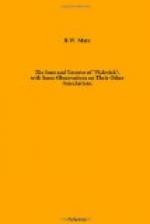Is it to be wondered at that the City Pickwick Club should hold its meetings and dinners there, or that the Dickens Fellowship should choose it as the most appropriate spot for the entertainment of their American and colonial visitors, and occasionally to have convivial gatherings of its members there?
And will it surprise anyone if a universal agitation is set on foot to preserve it from the axe and pick of the builder which threatens it in the near future?
There is one extraordinarily interesting piece of history relative to the “George and Vulture” and Pickwick with which fittingly to close this account of London’s famous inn.
In 1837, the year that The Pickwick Papers appeared in monthly-parts, a Circulating Book Society had its headquarters at the “George and Vulture.” On the occasion of the meeting held on March 30, 1837, it was proposed that The Pickwick Papers, “now in course of publication, be taken in for circulation.”
This motion was opposed by two members “who considered the work vulgar.” The motion, however, was carried with the amendment “that the work, when complete, be obtained and circulated as one volume.” In 1838 this famous copy of the immortal work was sold by auction amongst the members, in what was probably the very room Dickens had in mind when describing the meetings of Mr. Pickwick and his friends. It was bought by J. Buckham for 13s. 6d. This copy was annotated by the owner with notes, historical and explanatory, and is now a cherished possession of the nation in the safe custody of the Library of the British Museum, where it is known as the “George and Vulture” copy.
CHAPTER XII
The “Blue boar, “Leadenhall
market,” Garraway’s,”
And the “White horse Cellar”
The “Blue Boar,” Leadenhall Market, was an inn of considerable Pickwickian importance. It was the elder Weller’s favourite house of call, and it will be remembered that Sam was sent for by his father on one occasion to meet him there at six o’clock. Having obtained Mr. Pickwick’s permission to absent himself from the “George and Vulture,” Sam sauntered down as far as the Mansion House, and then by easy stages wended his way towards Leadenhall Market, through a variety of by-streets and courts, purchasing a Valentine on his way.
Looking round him he beheld a signboard on which the painter’s art had delineated something remotely resembling a cerulean elephant with an aquiline nose in lieu of a trunk. Rightly conjecturing that this was the “Blue Boar” himself, he stepped into the house and enquired concerning his parent. Finding that his father would not be there for three-quarters of an hour or more, he ordered from the barmaid “nine penn’orth o’ brandy and water hike, and the ink-stand,” and having settled himself in the little parlour, composed himself to write that wonderful “walentine” to Mary. Just as Sam had finished his missive his father appeared on the scene, and he was invited by the dutiful son to listen to what he had written. Tony heard it through, punctuating it during the process with a running commentary and much advice on marriage in general and “widders” in particular.




